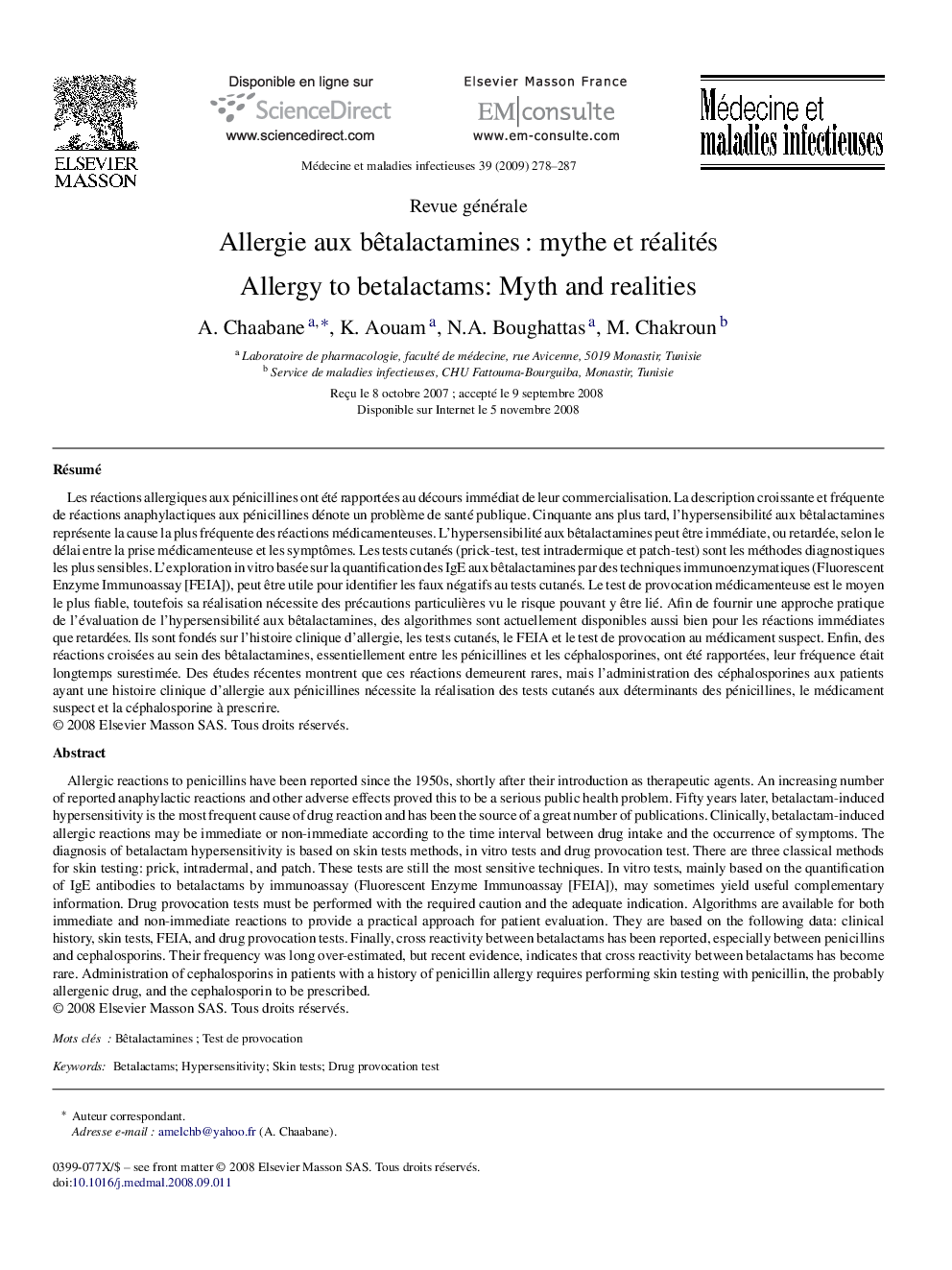| کد مقاله | کد نشریه | سال انتشار | مقاله انگلیسی | نسخه تمام متن |
|---|---|---|---|---|
| 3413621 | 1224305 | 2009 | 10 صفحه PDF | دانلود رایگان |

RésuméLes réactions allergiques aux pénicillines ont été rapportées au décours immédiat de leur commercialisation. La description croissante et fréquente de réactions anaphylactiques aux pénicillines dénote un problème de santé publique. Cinquante ans plus tard, l’hypersensibilité aux bêtalactamines représente la cause la plus fréquente des réactions médicamenteuses. L’hypersensibilité aux bêtalactamines peut être immédiate, ou retardée, selon le délai entre la prise médicamenteuse et les symptômes. Les tests cutanés (prick-test, test intradermique et patch-test) sont les méthodes diagnostiques les plus sensibles. L’exploration in vitro basée sur la quantification des IgE aux bêtalactamines par des techniques immunoenzymatiques (Fluorescent Enzyme Immunoassay [FEIA]), peut être utile pour identifier les faux négatifs au tests cutanés. Le test de provocation médicamenteuse est le moyen le plus fiable, toutefois sa réalisation nécessite des précautions particulières vu le risque pouvant y être lié. Afin de fournir une approche pratique de l’évaluation de l’hypersensibilité aux bêtalactamines, des algorithmes sont actuellement disponibles aussi bien pour les réactions immédiates que retardées. Ils sont fondés sur l’histoire clinique d’allergie, les tests cutanés, le FEIA et le test de provocation au médicament suspect. Enfin, des réactions croisées au sein des bêtalactamines, essentiellement entre les pénicillines et les céphalosporines, ont été rapportées, leur fréquence était longtemps surestimée. Des études récentes montrent que ces réactions demeurent rares, mais l’administration des céphalosporines aux patients ayant une histoire clinique d’allergie aux pénicillines nécessite la réalisation des tests cutanés aux déterminants des pénicillines, le médicament suspect et la céphalosporine à prescrire.
Allergic reactions to penicillins have been reported since the 1950s, shortly after their introduction as therapeutic agents. An increasing number of reported anaphylactic reactions and other adverse effects proved this to be a serious public health problem. Fifty years later, betalactam-induced hypersensitivity is the most frequent cause of drug reaction and has been the source of a great number of publications. Clinically, betalactam-induced allergic reactions may be immediate or non-immediate according to the time interval between drug intake and the occurrence of symptoms. The diagnosis of betalactam hypersensitivity is based on skin tests methods, in vitro tests and drug provocation test. There are three classical methods for skin testing: prick, intradermal, and patch. These tests are still the most sensitive techniques. In vitro tests, mainly based on the quantification of IgE antibodies to betalactams by immunoassay (Fluorescent Enzyme Immunoassay [FEIA]), may sometimes yield useful complementary information. Drug provocation tests must be performed with the required caution and the adequate indication. Algorithms are available for both immediate and non-immediate reactions to provide a practical approach for patient evaluation. They are based on the following data: clinical history, skin tests, FEIA, and drug provocation tests. Finally, cross reactivity between betalactams has been reported, especially between penicillins and cephalosporins. Their frequency was long over-estimated, but recent evidence, indicates that cross reactivity between betalactams has become rare. Administration of cephalosporins in patients with a history of penicillin allergy requires performing skin testing with penicillin, the probably allergenic drug, and the cephalosporin to be prescribed.
Journal: Médecine et Maladies Infectieuses - Volume 39, Issue 5, May 2009, Pages 278–287